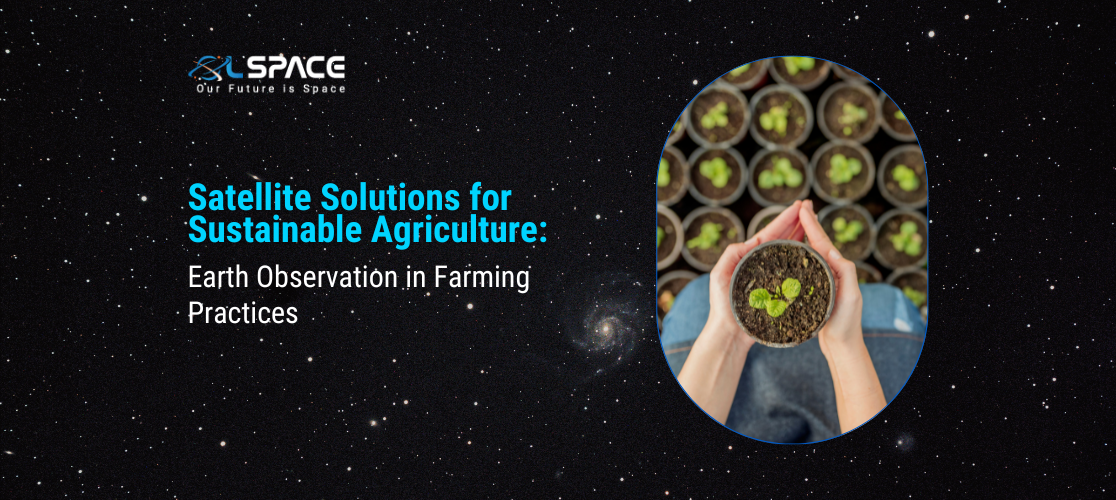01 December 2023
Satellite Solutions for Sustainable Agriculture: Earth Observation in Farming Practices

As the global population continues to rise, the need for sustainable agriculture practices becomes increasingly critical. Satellite-based Earth observation technologies offer innovative solutions to address the challenges faced by the agriculture sector. This article explores how satellite solutions contribute to sustainable agriculture by providing valuable insights, optimising resource management, and supporting informed decision-making in farming practices.
1. Precision Farming through Remote Sensing:
Insights for Farmers: Satellite imagery provides high-resolution data, enabling farmers to monitor crop health, identify pest infestations, and assess overall field conditions remotely.
Optimising Resources: Precision agriculture techniques, informed by satellite observations, help optimise the use of water, fertilisers, and pesticides by targeting specific areas that require intervention, reducing environmental impact.
2. Crop Monitoring and Yield Prediction:
Insights for Farmers: Satellites continuously monitor crop growth and development throughout the growing season, allowing farmers to track changes, detect anomalies, and predict potential yields.
Optimising Resources: Accurate yield predictions based on satellite data enable farmers to plan harvest logistics, manage storage, and optimise market strategies, contributing to more efficient resource utilisation.
3. Soil Health Assessment:
Insights for Farmers: Earth observation satellites assess soil properties, moisture levels, and nutrient content. This information aids farmers in making informed decisions about soil health management.
Optimising Resources: Satellite-derived soil data supports precision agriculture by guiding optimal irrigation and fertilisation practices, minimising input waste, and promoting sustainable soil management.
4. Water Management and Irrigation:
Insights for Farmers: Satellite imagery assists in monitoring water availability, identifying irrigation needs, and assessing the impact of drought or excessive rainfall on crops.
Optimising Resources: By integrating satellite data into irrigation systems, farmers can implement precise and timely irrigation strategies, conserving water resources and mitigating the risk of overwatering.
5. Pest and Disease Detection:
Insights for Farmers: Satellite-based monitoring helps detect early signs of pest infestations and disease outbreaks, allowing farmers to implement targeted interventions and reduce crop losses.
Optimising Resources: By addressing pest and disease issues promptly, farmers can minimise the need for widespread pesticide application, reducing environmental impact and optimising resource use.
6. Land Use Planning and Crop Rotation:
Insights for Farmers: Satellite imagery provides valuable information on land use patterns, allowing farmers to plan effective crop rotations, diversify their agricultural practices, and enhance soil health.
Optimising Resources: Strategic land use planning, informed by satellite observations, contributes to sustainable farming by preventing soil degradation, reducing monoculture risks, and promoting biodiversity.
7. Climate Resilience and Risk Management:
Insights for Farmers: Satellites help monitor weather patterns, predict extreme events, and assess the impact of climate-related risks, enabling farmers to implement adaptive strategies.
Optimising Resources: By proactively managing climate-related risks, farmers can enhance resilience, reduce losses, and optimise resource allocation in response to changing weather patterns.
8. Sustainable Agriculture Certification:
Insights for Farmers: Satellite data can contribute to the verification and monitoring required for sustainable agriculture certifications by providing evidence of compliance with environmental and conservation practices.
Optimising Resources: Certification based on satellite observations enhances market access for farmers engaged in sustainable practices, fostering economic benefits and incentivising environmentally responsible agriculture.
Conclusion: Nurturing Sustainable Agriculture from Space
Satellite solutions play a pivotal role in advancing sustainable agriculture by providing farmers with critical insights, optimising resource management, and enhancing overall resilience. As technology continues to evolve, the integration of satellite-based Earth observation into farming practices holds the promise of fostering a more sustainable and productive future for agriculture worldwide. By leveraging the power of satellites, farmers can make informed decisions that benefit both their livelihoods and the planet.
